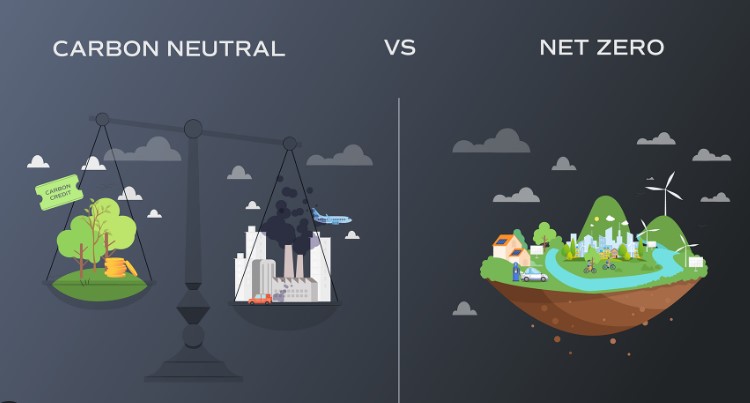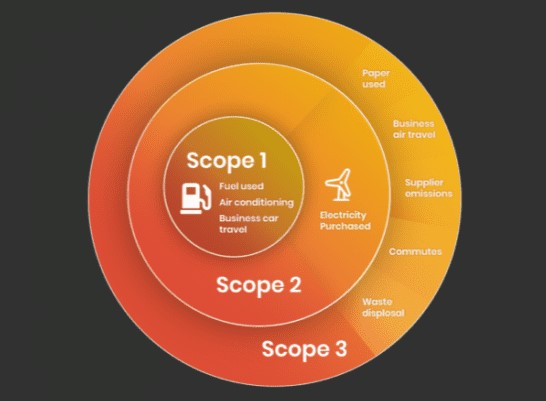The discourse around environmental sustainability has intensified, with a significant focus on reducing carbon emissions. Amidst the myriad of terms and strategies proposed to mitigate climate change, “carbon neutral” and “net zero” stand out as pivotal concepts. Both approaches aim at curbing the adverse effects of carbon dioxide in our atmosphere, yet they operate on distinct principles and methodologies.
Carbon neutrality is achieved when an entity offsets the same amount of carbon dioxide it emits into the atmosphere, essentially balancing out its carbon footprint. On the other hand, reaching net zero refers to a state where the amount of greenhouse gases emitted is equal to the amount removed from the atmosphere. While both goals strive for a sustainable future, their paths and implications differ significantly.
Understanding these concepts is crucial for individuals, businesses, and governments as they navigate the complexities of environmental policies and practices. The differentiation between carbon neutral and net zero not only influences global climate action plans but also dictates the responsibilities and strategies entities must adopt to contribute effectively to the global effort against climate change.

Carbon Footprint Basics
Definitions
A carbon footprint measures the total amount of greenhouse gases, primarily carbon dioxide (CO2), that activities or entities produce. Every individual, business, and nation contributes to the global carbon footprint through activities like driving, manufacturing, and electricity use. This footprint is typically measured in tons of CO2 equivalent per year, reflecting the global impact of emissions.
Importance
Reducing our carbon footprint is not just beneficial; it’s imperative for environmental sustainability. The buildup of CO2 and other greenhouse gases in the atmosphere traps heat, leading to climate change. This change manifests in extreme weather, rising sea levels, and biodiversity loss, affecting every corner of the globe. By minimizing our carbon emissions, we can slow the pace of climate change, ensuring a healthier planet for future generations.
Carbon Neutral Explained
Concept Overview
Carbon neutrality means balancing the amount of carbon dioxide emitted with an equal amount removed from the atmosphere. Achieving carbon neutrality involves calculating an entity’s carbon emissions and then compensating for those emissions through various offsetting measures. These measures could include planting trees, which absorb CO2, or investing in renewable energy projects that displace fossil fuel usage.
Path to Carbon Neutrality
The journey to carbon neutrality involves several key steps:
- Emission Assessment: Calculate the total greenhouse gas emissions produced.
- Reduction Strategies: Implement ways to reduce emissions, such as energy efficiency improvements.
- Offsetting: Compensate for any remaining emissions by investing in carbon offset projects.
Each step requires commitment and innovation, aiming to reduce the overall impact of carbon emissions on the environment.
Net Zero Fundamentals
Definition
Net zero goes a step beyond carbon neutrality. To achieve net zero emissions, an entity must balance the amount of greenhouse gases emitted with the amount removed from the atmosphere. However, the focus is more on reducing actual emissions rather than relying on offsets. Achieving net zero means drastically reducing greenhouse gas emissions and only using offsets for the remaining, unavoidable emissions.
Achieving Net Zero
The path to net zero is more intensive and involves:
- Deep Emission Reductions: Prioritize cutting emissions as much as possible through technological innovation and changes in practices.
- Renewable Energy: Shift to renewable energy sources like wind, solar, and hydroelectric power.
- Carbon Removal: Use natural or technological solutions to remove CO2 from the atmosphere.
This approach demands significant changes in how we produce and consume energy, aiming for a sustainable balance with the Earth’s natural systems.
Key Differences
Comparison
While both carbon neutral and net zero aim to address climate change, their approaches and implications differ:
- Carbon Neutral: Focuses on balancing emitted carbon with offsets.
- Net Zero: Emphasizes reducing emissions to the lowest possible level, using offsets only as a last resort.
Impact
The environmental impact of each approach varies:
- Carbon Neutral: Helps to mitigate climate change effects by offsetting emissions, but does not necessarily lead to a reduction in the amount of greenhouse gases produced.
- Net Zero: Directly contributes to a decrease in global greenhouse gas concentrations, offering a more sustainable and long-term solution to climate change.
Strategies and Solutions
For Businesses
Businesses play a crucial role in achieving carbon neutrality and net zero targets. Here are strategies they can adopt:
Reduce Energy Consumption
- Conduct energy audits to identify savings opportunities.
- Implement energy-efficient lighting, heating, and cooling systems.
Invest in Renewable Energy
- Purchase green energy from renewable sources.
- Install solar panels or wind turbines on-site.
Enhance Supply Chain Sustainability
- Choose suppliers committed to sustainable practices.
- Minimize waste and optimize logistics for lower emissions.
Encourage Remote Work
- Reduce office space and energy use.
- Cut down on employee commuting emissions.
Carbon Offsetting
- Invest in reforestation projects or renewable energy credits.
- Support carbon capture and storage initiatives.
For Individuals
Individual actions are also vital in the fight against climate change. Here’s how individuals can contribute:
Reduce Energy Use at Home
- Use energy-efficient appliances and light bulbs.
- Insulate homes to reduce heating and cooling needs.
Choose Sustainable Transportation
- Use public transport, cycle, or walk instead of driving.
- Consider electric or hybrid vehicles for longer distances.
Adopt a Plant-based Diet
- Lower meat consumption to reduce methane emissions.
- Support local, organic farming practices.
Reduce, Reuse, Recycle
- Minimize waste and single-use plastics.
- Recycle electronics, plastics, and other materials properly.
Support Green Initiatives
- Purchase from companies with sustainable practices.
- Participate in or donate to environmental conservation projects.
Challenges and Considerations
Technological Barriers
Achieving carbon neutrality and net zero often requires advanced technology, which presents its own challenges:
High Costs
- Initial investment in green technology can be prohibitive for many.
Scalability
- Scaling up renewable energy and carbon capture solutions to meet global needs is complex.
Reliability and Storage
- Ensuring consistent energy supply from renewables necessitates effective storage solutions.
Economic Factors
The transition to a low-carbon economy involves significant economic considerations:
Investment Requirements
- Substantial funds are needed to develop and deploy green technologies.
Job Transition
- Shifting from fossil fuel to green jobs requires retraining and support for affected workers.
Market Dynamics
- Carbon pricing and incentives must balance encouraging green investments without overly burdening consumers or businesses.
Global Efforts and Policies
International Agreements
Several key international agreements aim to reduce global carbon emissions:
Paris Agreement
- Nations commit to limiting global warming and enhancing green technology.
Kyoto Protocol
- Sets emission reduction targets for developed countries.
United Nations Sustainable Development Goals
- Includes goals for affordable and clean energy, responsible consumption, and climate action.
Country-Specific Initiatives
Countries around the world are adopting various strategies to meet their climate goals:
European Union
- Aims for carbon neutrality by 2050 with the European Green Deal.
China
- Pledged to reach carbon neutrality by 2060 and peak emissions before 2030.
United States
- Rejoined the Paris Agreement, committing to aggressive emission reductions.
Future Prospects
Technological Innovations
The future success in achieving carbon neutrality and net zero will largely depend on technological advancements:
Carbon Capture and Storage (CCS)
- Improvements in efficiency and cost will make CCS a viable solution for heavy industries.
Renewable Energy Technologies
- Continued innovation in solar, wind, and hydroelectric power will lower costs and increase adoption.
Electric Vehicles (EVs)
- Advances in battery technology will improve range and reduce charging times, making EVs more accessible.
Role of Renewable Energy
Renewable energy sources are set to become the backbone of the transition to a low-carbon future:
Solar and Wind
- Increased efficiency and lower costs will make these the most common forms of energy generation.
Hydrogen Fuel
- Developments in green hydrogen production could revolutionize industries and transport.
Grid Modernization
- Enhancing grid infrastructure to handle renewable sources reliably is essential.
Frequently Asked Questions
What is Carbon Neutrality?
Carbon neutrality involves balancing emitted carbon dioxide with an equivalent amount of carbon offsetting or sequestration, aiming for a net-zero carbon footprint. This balance can be achieved through various means, including planting trees, investing in renewable energy, or purchasing carbon credits.
How is Net Zero Different from Carbon Neutral?
Net zero refers to the balance between the amount of greenhouse gases produced and the amount removed from the atmosphere. Unlike carbon neutrality, which can be achieved through offsets, net zero requires significant reductions in actual emissions, making it a more ambitious goal.
Why are Carbon Neutral and Net Zero Important?
These concepts are crucial in the fight against climate change, guiding entities in reducing their environmental impact. Achieving carbon neutral or net zero status helps mitigate global warming and promotes sustainability by encouraging the adoption of greener practices and technologies.
Can Individuals Contribute to Achieving These Goals?
Yes, individuals can contribute by reducing their carbon footprint through lifestyle changes, such as using public transport, reducing energy consumption, recycling, and supporting sustainable businesses and products. Every action counts towards the larger goal of environmental sustainability.
Conclusion
The journey towards mitigating climate change is complex and multifaceted, with carbon neutrality and net zero serving as critical milestones. These concepts not only symbolize commitment to a sustainable future but also set the foundation for actionable strategies that reduce the impact of climate change. By understanding and differentiating between carbon neutral and net zero, societies can better align their efforts with the global objectives of environmental preservation and climate action.
As the world strides towards these ambitious goals, the collective efforts of governments, businesses, and individuals will be paramount. It’s a path that requires innovation, collaboration, and relentless pursuit of sustainability. Recognizing the significance of each step towards carbon neutrality or net zero can empower us all to take more informed and impactful actions in our daily lives and organizational practices, contributing to a healthier planet for future generations.

